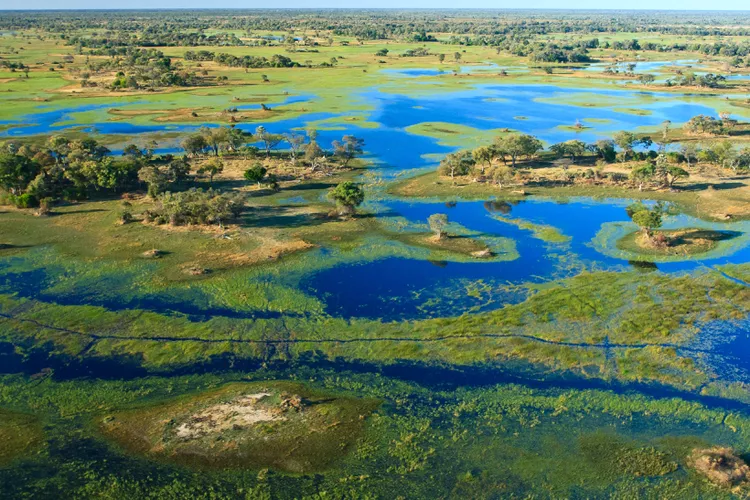Summary of Botswana Travel Guide
One of Southern Africa’s most exclusive safari destinations, Botswana is a true wildlife haven. Its landscapes are as diverse as they are beautiful, ranging from the lush wetlands of the Okavango Delta to the arid drama of the Kalahari Desert. Botswana is also one of Africa’s most stable countries, with a conscientious government and a relatively high standard of living.
Location and Geography
Botswana is a land-locked country in central Southern Africa. It shares land borders with Namibia, Zambia, Zimbabwe, and South Africa. Geographically, it is mostly flat (although there are a few hilly regions). Notable features include the Okavango Delta in the northwest; the Mkgadikgadi Pans in the northern center; and the Kalahari Desert in the central and southwest.
The total area of Botswana is 224,607 square miles/581,730 square kilometers, making the country slightly smaller than Texas. Botswana’s capital city is Gaborone, located in the southeast near the South African border.
Population and Languages
The CIA World Factbook estimated Botswana’s population to be just over 2.2 million in July 2016. The Tswana or Setswana people comprise the country’s largest ethnic group, accounting for 79% of the population.
The official language of Botswana is English, but it is spoken as a mother tongue by just 2.8% of the population. Seventy-seven percent of Botswanans speak Setswana, the most prevalent native language.
Christianity is practiced by almost 80% of Botswanans. A minority still follow traditional beliefs like Badimo, the worship of ancestors.
Currency
The official currency is the Botswana pula. Utilize this online converter for accurate exchange rates.
Climate & When to Go
Botswana has a semi-arid climate characterized by hot days and cool nights throughout the year. The dry season usually lasts from May to October and coincides with the southern hemisphere winter, resulting in chilly nights and early mornings. The rainy season spans from December to March and is the hottest time of the year.
Generally, the best time to visit Botswana is during the dry season when temperatures are pleasant, mosquitoes are minimal, and wildlife viewing is easier due to less foliage. However, the wet season is particularly rewarding for birdwatchers and those seeking a greener experience in the Kalahari Desert.

Key Attractions
Okavango Delta
In the country’s northwest corner lies the Okavango, a vast river delta surrounded by the Kalahari Desert. Annually, the Delta floods, creating a swampy wetland that teems with exotic animals and birds. It is possible to explore on foot or via traditional canoe, known locally as a mokoro. The Okavango Delta is recognized as a UNESCO World Heritage Site, and nearby Moremi Game Reserve is one of the best places in Africa for spotting leopards.
Chobe National Park
East of the Delta lies Chobe National Park, renowned for its sizable elephant population and Savuti Marsh, which boasts one of the highest year-round animal concentrations in Africa. During the dry season, wildlife converges at the Chobe River, making water safaris particularly fulfilling at this time. The local birdlife is extraordinary, featuring regional specialties like African skimmers and Pel’s fishing owls.
Nxai Pan National Park
Centered around a fossil lake bed south of Chobe National Park, Nxai Pan National Park presents a distinct landscape of sloping sand dunes and towering baobab trees. It floods during summer, offering an excellent low season for game viewing and birdwatching. In winter, the dry park resembles the surface of the moon with vast cracked salt pans stretching endlessly. The park shares a border with Mkgadikgadi Pans National Park.
Tsodilo Hills
In the far northwest, the Tsodilo Hills serve as an outdoor museum for San bushman culture. Among rock outcrops and hills are approximately 4,000 rock paintings, providing insight into the lives of the ancient San, believed to be the direct descendants of early Homo sapiens. The hills held significant spiritual value for local tribes, with many paintings depicting the sacred eland antelope.
Getting There
The primary entry point for international visitors is Sir Seretse Khama International Airport (GBE), situated just outside Gaborone. Moreover, traveling overland to Botswana from neighboring countries like Namibia and South Africa is feasible. Citizens of most developed countries do not require a visa for short visits. For a comprehensive list of visa rules and requirements, visit the official government website.
Medical Requirements
Before traveling to Botswana, ensure that your routine vaccines are current. Hepatitis A and typhoid vaccinations are recommended; additionally, anti-malaria prophylactics may be necessary depending on your travel plans. The CDC provides further information about healthcare precautions.





